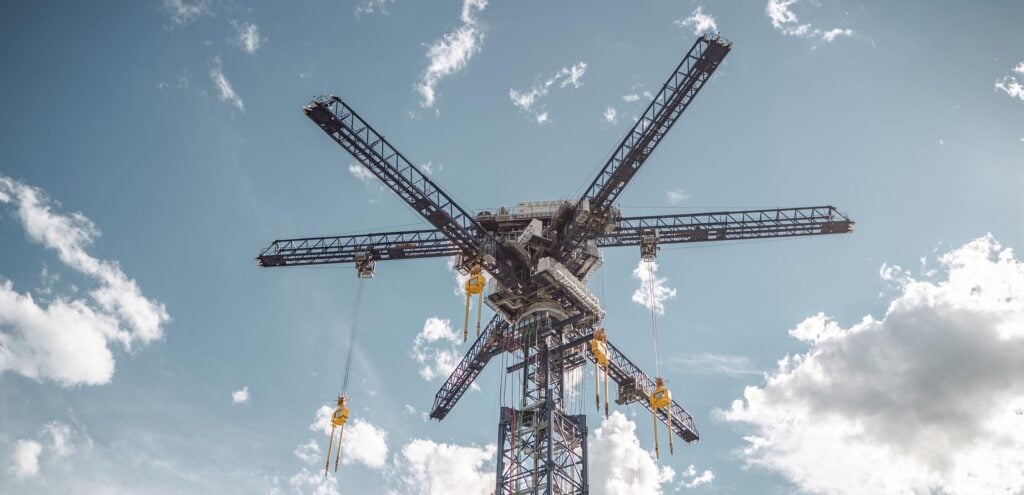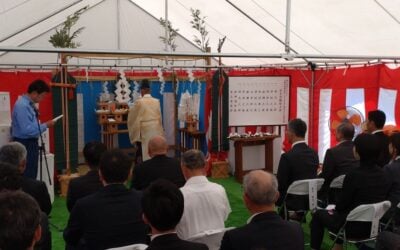
Energy Vault has become the latest startup with a novel, non-lithium battery energy storage technology to attract significant investment, raising US$100 million through a Series C funding round.
The company’s giant systems use cranes that lift, swing and lower 35-tonne blocks of a composite concrete-like material, harnessing gravitational and kinetic energy to store and release energy. The technology is claimed by Energy Vault to be scalable for use in either shorter duration 2-6 hour applications or much longer 6 hour+ durations. The technology is designed to offer 80% to 85% round-trip efficiency.
Enjoy 12 months of exclusive analysis
- Regular insight and analysis of the industry’s biggest developments
- In-depth interviews with the industry’s leading figures
- Annual digital subscription to the PV Tech Power journal
- Discounts on Solar Media’s portfolio of events, in-person and virtual
Resembling a cross between a construction site and a theme park ride, the Swiss-American company’s tech has already been invested in by the likes of Softbank Vision Fund and Saudi Aramco Energy Ventures. That pair joined the latest funding round, along with other innovation and breakthrough-focused venture capital (VC) groups like Prime Movers Lab — which led the round — Helena Capital Partners and Idealab X which were also all existing investors in Energy Vault.
A group of new investors also joined this time, including the Energy Equity Opportunity Fund run by Pickering Energy Partners, Green Storage Solutions Venture I, SailingStone Global Energy Transition and others. Meanwhile financial advisors on the transaction were Goldman Sachs and Stifel.
Energy Vault has so far built one 5MW commercial demonstration project. The company claims its technology is non-degrading in storage capacity over time and can have more than three decades of operational life. It can easily be decommissioned, Energy Vault claims, and built using locally available materials and components. This is part of an approach that could support local job creation for projects and reduce greenhouse gas (GHG) emissions related to their deployment.
A recent partnership agreement was signed with Enel Green Power to investigate if the latter’s wind turbine blades can be recycled to form the system’s composite block weights once the blades reach the end of their life at wind farms.
With commercial deployments expected to begin in the US before the end of this year and ramping up through 2022, Energy Vault has dubbed the newest iteration of its design EVx, launched in April. EVx units could be as tall as 30-storey skyscrapers — but could also be built 45% lower in height than that depending on location and requirements — with the cranes and pulleys controlled using Energy Vault’s proprietary software.
Latest in a wave of non-lithium tech investments
The funding raise follows in quick succession after Form Energy announced this week the successful closing of a US$240 million Series D. Form Energy has developed an iron-air chemistry battery that it claimed can store energy for in excess of 100 hours at a low cost. Also in the past few weeks, another startup with a novel long-duration electrochemical storage technology, Ambri, raised US$144 million for its high temperature liquid metal battery storage system business in early August. A VC arm of Koch Industries committed to investing US$100 million in zinc hybrid cathode battery storage company Eos Energy Enterprises in July.
Other non-electrochemical contenders in the novel long-duration tech race alongside Energy Vault which have raised investment in the recent past include Malta Inc, which has a ‘pumped heat’ thermal energy storage system. Malta said yesterday that its ongoing Series B funding round which had reached US$50 million by March this year has now reached US$60 million. One of Malta’s newest investors is Chevron Energy Ventures, joining the likes of Facebook co-founder Dustin Moskowitz and Bill Gates’ Breakthrough Energy Ventures.
Another thermal energy storage startup, EnergyNest, netted just over US$130 million in April this year for its system of storing heat in a special form of concrete that has metal pipes running a heat transfer fluid through the concrete ‘bricks’.
Other investment targets include Highview Power, which has a proprietary liquid air energy storage (LAES) technology and Hydrostor, which has developed an advanced compressed air energy storage (A-CAES) system using underground salt caverns to store air.
Meanwhile alternative gravity-based energy storage technologies are being developed and promoted by the likes of Gravitricity in the UK — which raises and drops weights up and down a vertical shaft — and ARES in the US, which hauls carts loaded with weight up hills and drops them down along rail tracks to release energy.






